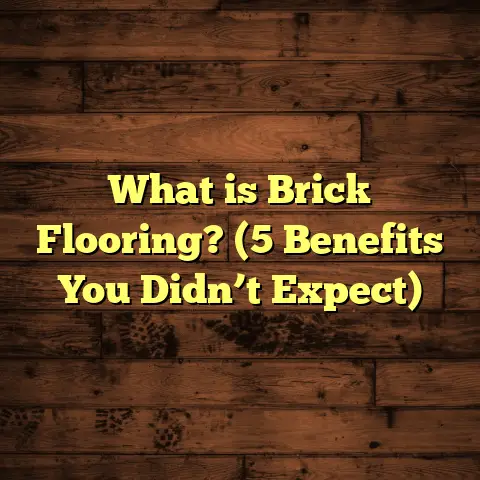What is a Crater Floor Collapse? (5 Key Causes Explained)
What is a Crater Floor Collapse?
Have you ever walked across a concrete floor and suddenly noticed a spot where the surface seems to dip sharply, forming a shape that looks a lot like a tiny crater on the moon? If so, you’ve probably encountered what’s called a crater floor collapse. But what does that really mean, and why should you care?
A crater floor collapse is when a specific area of your floor suddenly caves in or sinks, creating a depression or hole resembling a crater. It’s not just an ugly blemish—it’s a serious problem that can affect the safety and longevity of your flooring system.
I’ve been in the flooring business for over 15 years, dealing with all sorts of floor failures. Crater collapses are tricky because they often signal an underlying issue beneath the surface that’s not immediately visible. Understanding what causes these craters helps you avoid costly repairs and potential hazards.
Let me take you through everything I’ve learned about crater floor collapse: what it is, why it happens, how to spot it early, and most importantly—how to prevent it.
The Anatomy of a Crater Floor Collapse
Before diving into causes, it’s helpful to understand the structure of typical flooring systems and how they can fail.
Concrete floors are made up of layers:
- Surface slab: Usually poured concrete or other finished flooring material.
- Subfloor or base: This is either a compacted soil layer, gravel, or insulation material.
- Subgrade: The natural ground or soil underneath everything.
Each layer has a job: supporting weight evenly and preventing movement. When one layer weakens or moves unexpectedly, it can cause the floor above to sink or crack.
A crater collapse occurs when the support beneath a small area fails—often suddenly—so the floor surface caves in. This localized failure differs from general cracking or settling that happens evenly.
How Serious is a Crater Floor Collapse?
You might be thinking, “Is this just an eyesore, or should I be worried?”
Crater collapses are serious because:
- They compromise structural integrity.
- They can create trip hazards or damage equipment.
- They indicate potential ongoing issues like soil erosion or water damage.
- If left unchecked, these small craters can expand and cause major floor failures.
In commercial or industrial settings, crater collapses can disrupt operations and lead to expensive downtime. In homes, they can affect property value and safety.
5 Key Causes of Crater Floor Collapse Explained in Depth
1. Soil Settlement or Erosion Beneath the Floor
When I first started working as a flooring contractor, this was by far the most common cause I encountered. Soil settlement means the ground below your slab compresses or shifts unevenly.
Why does soil settle?
- Poor compaction during construction: If soil wasn’t packed tightly enough before pouring concrete, it will compress under weight.
- Organic material decay: Roots or old debris break down over time.
- Water erosion: Rainwater, flooding, or plumbing leaks wash soil particles away.
I once worked on a warehouse project where unexpected heavy rainfall caused pockets of sandy soil to wash away beneath the slab. Multiple craters formed over several months.
Technical data:
- Soil settlement rates vary depending on soil type. Sandy soils can erode quickly; clay soils may settle slowly but unpredictably.
- The Proctor test is used to measure soil compaction; less than 95% Proctor density significantly raises risk of settlement.
- According to the Federal Highway Administration, improperly compacted subgrade accounts for nearly 40% of premature concrete slab failures.
Real-world tip: If you are planning to pour concrete floors, insist on proper geotechnical assessments and soil compaction tests. Don’t let contractors skip these steps—they save time but cost you later.
2. Poor Concrete Mix or Manufacturing Defects
Concrete strength depends heavily on how well it’s mixed and cured. When concrete isn’t made properly, its durability suffers.
What goes into good concrete?
- Cement (usually Portland cement).
- Aggregates (sand, gravel).
- Water.
- Sometimes admixtures (chemicals that improve properties).
The key is balancing water and cement content. Too much water makes concrete weak and porous; too little makes it hard to work with.
I remember a retail store floor I worked on where the contractor used an overly watery mix to make pouring easier. Within six months, several craters appeared because the slab couldn’t resist surface loads or moisture damage.
Manufacturing process details:
- Batching: Measuring ingredients precisely.
- Mixing: Combining thoroughly for uniform consistency.
- Placing: Pouring without delays to prevent premature drying.
- Curing: Maintaining moisture for at least 7 days to allow chemical hydration.
Skipping any of these steps compromises strength. For example, improper curing reduces compressive strength by up to 30%.
Data from standards:
- The American Concrete Institute recommends minimum compressive strength of 3000 psi for residential slabs.
- High-performance floors might require 4000+ psi for industrial use.
3. Inadequate Subfloor Preparation
You wouldn’t build a house on shaky foundations—same with floors!
The subfloor must be clean, compacted, and free from organic materials before pouring concrete. Organic debris like roots or leaves decay over time and create voids under your slab.
One home renovation I did turned into a nightmare because the builder neglected this step. Tree roots decomposed under the slab, causing small collapses within months.
Best practices for subfloor prep:
- Clear all organic material.
- Compact soil using heavy rollers or vibratory plates.
- Install vapor barriers if moisture is a concern.
Without this prep, you risk gradual settling and eventual collapse.
4. Water Damage and Moisture Intrusion
Water is one of the most destructive forces for floors—especially concrete.
Leaks from plumbing or poor drainage cause moisture to seep under slabs. Over time:
- Water erodes supporting soil.
- Freeze-thaw cycles cause cracks.
- Mold growth weakens materials.
At an industrial plant I consulted for, persistent leaks caused massive crater collapses under heavy machinery areas. Remediation involved fixing leaks and installing drainage channels around the slab perimeter.
Technical insight:
- Concrete is porous; without proper sealing or vapor barriers, moisture migrates upward.
- Freeze-thaw damage happens when water freezes in pores and expands by roughly 9%, cracking concrete internally.
Moisture meters and infrared thermography are tools I use to detect hidden water damage early.
5. Overloading Beyond Design Capacity
Floors aren’t just slabs—they’re engineered systems designed for specific loads.
Imagine putting heavy steel racks designed for warehouses onto an office floor without reinforcement. The floor would crack and likely collapse locally under weight concentration.
One project involved converting office space into a manufacturing area without upgrading floors. The result? Multiple crater collapses under pallet racks due to weight beyond design specs.
Understanding load capacity:
- Residential floors typically support about 40 psf live load.
- Commercial floors vary but can range from 50 to over 200 psf depending on use.
Ignoring these specs risks structural failure fast.
How Crater Floor Collapse Develops Over Time
Crater collapse doesn’t usually happen overnight; it’s often preceded by warning signs:
- Small cracks appearing near depressions.
- Uneven floor surfaces.
- Drainage problems or persistent dampness around flooring.
If ignored, these worsen until the floor caves in completely in affected spots.
I always advise clients to monitor floors regularly, especially after extreme weather events or plumbing repairs.
Materials and Manufacturing Processes Affecting Floor Stability
When selecting materials for floors prone to heavy use or moisture exposure, understanding manufacturing processes helps avoid failures like crater collapses.
Concrete Mix Design
Mix design balances strength and workability:
- Cement-to-water ratio typically ranges from 0.40 to 0.60 by weight.
- Aggregate size affects surface finish and strength.
- Admixtures like plasticizers improve flow without extra water.
Reinforcement Techniques
Rebar or steel mesh embedded in slabs distributes load better and controls cracking:
- Rebar placed at mid-depth of slab.
- Steel mesh often used in residential or light commercial floors.
Curing Methods
Proper curing retains moisture:
- Wet curing via spraying/misting.
- Covering slabs with plastic sheets.
- Using curing compounds that seal moisture in.
Skipping curing leads to weak surfaces prone to cracking and crater formation.
Case Study #1: Warehouse Floor Collapse Due to Soil Erosion
A large distribution center experienced multiple crater collapses after heavy seasonal rains.
Investigation findings:
- Soil beneath slab was sandy with poor drainage.
- Water pooled near building foundation due to blocked gutters.
Solutions implemented:
- Regraded site to improve runoff.
- Installed French drains around perimeter.
- Excavated affected slabs and rebuilt subgrade with compacted gravel.
This case highlighted how environmental factors interact with construction defects to cause failures.
Case Study #2: Residential Patio Collapse from Poor Subfloor Prep
A homeowner called me after their new patio developed sunken spots within a year.
Cause:
Contractor hadn’t removed decaying roots beneath slab before pouring concrete.
Fix:
Removed affected slab areas; excavated organic matter; compacted soil; repoured with proper mix and curing.
This is a common issue in residential projects where landscaping overlaps with construction zones.
Frequently Asked Questions About Crater Floor Collapse
Can I fix craters myself?
Small craters might be patched temporarily using epoxy fillers, but long-term fixes require addressing underlying causes like soil compaction or drainage issues. DIY fixes often fail without proper repairs beneath the slab.
How much does repair typically cost?
Costs vary widely depending on crater size and underlying problems:
- Minor patching: $200-$500
- Excavation and repouring: $2,000-$15,000+
Getting professional assessment saves money by avoiding repeat failures.
How long does concrete take to cure properly?
Standard curing takes at least 7 days for most strength development but full strength continues up to 28 days under ideal conditions.
My Personal Advice for Anyone Dealing With Crater Floor Collapse
If you suspect crater collapse:
- Don’t ignore signs like cracks or dips.
- Call in professionals early for soil testing and structural assessment.
- Check drainage around your property regularly.
- Avoid overloading floors beyond their design limits.
- Keep records of construction quality—mix specs, compaction tests, curing procedures.
Conclusion (Without Saying ‘Conclusion’)
Crater floor collapse may seem mysterious when you first spot it—but there are clear reasons behind it. Whether it’s bad soil compaction, water damage, poor concrete quality, inadequate preparation, or excessive loads—the causes are usually traceable with careful inspection.
Over my years working with floors of all types—from homes to warehouses—I’ve seen firsthand how preventable these problems are when standards are followed closely. When issues arise, taking action early prevents small craters from turning into costly disasters.
Next time you notice a dip in your floor that looks like a tiny moon crater—now you know what could be going on below the surface!
If you want help assessing your floors or advice on repairs, feel free to reach out anytime—I’m here to share what I’ve learned and help keep your floors safe and sound.





